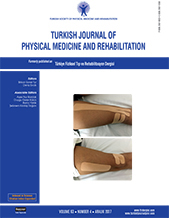Microvascular functions in patients with fibromyalgia syndrome effects of physical exercise
2 Department of Physical Medicine and Rehabilitation, Medical Faculty of Hacettepe University, Ankara, Turkey DOI : 10.5606/tftrd.2017.351 Objectives: This study aims to evaluate the current state of microvascular function and to investigate the effect of supervised aerobic exercise on microvascular control mechanisms and health outcomes in women with fibromyalgia syndrome (FMS).
Patients and methods: Forty female patients (mean age 51±11 years) with a diagnosis of FMS according to the American College of Rheumatology criteria and 20 healthy female controls (mean age 52±9 years) were included in the study. Microvascular blood flow was measured using a laser Doppler flowmeter (LDF) at the volar skin site of the forearm. Pain severity and FMS were assessed using the visual analog scale (VAS) and Fibromyalgia Impact Questionnaire (FIQ), respectively, both at the beginnig and at the end of the study. Fibromyalgia was evaluated and a spectral analysis of LDF signals was carried out to assess the relative contribution of each control mechanisms. The local thermal hyperemia was used to test the microvascular functions. Moderate-intensity aerobic activity (energy expenditure 3.0 to 6.0 metabolic equivalent) was performed by treadmill walking for 30 min for five days each week for a month.
Results: The patients with FMS had lower VAS and FIQ scores at the end of the exercise period. There was a positive correlation between improved myogenic and neurogenic mechanisms and reduced FIQ scores. Cardiac signals were positively correlated with the FIQ scores at the end of the exercise period. Endothelial function was under the influence of pain, and baseline nitric oxide activity was found to be positively correlated with VAS.
Conclusion: Our study results suggest that microvascular functions are impaired in FMS patients and moderate exercise training is effective to improve the FIQ/VAS scores and enhance vascular functions.
Keywords : Cutaneous circulation; fibromyalgia; physical exercise; spectral analysis
















